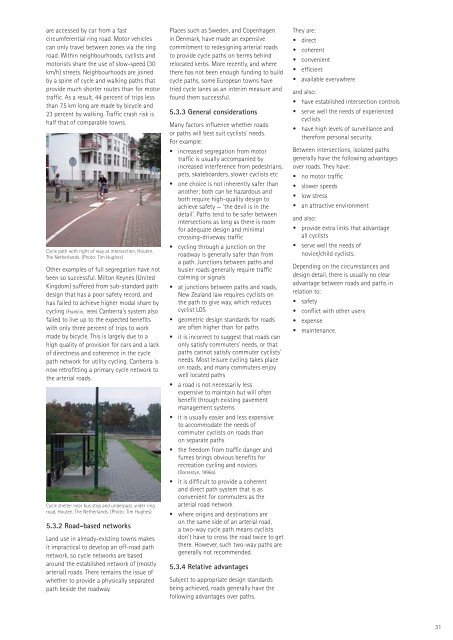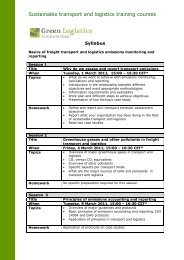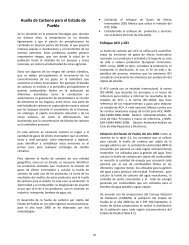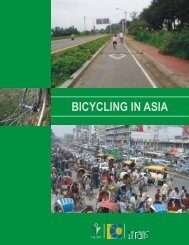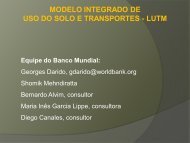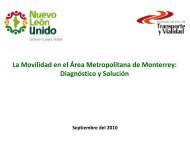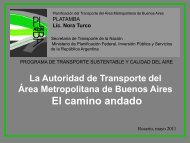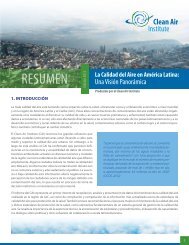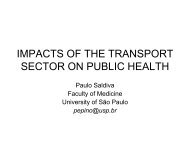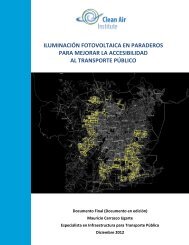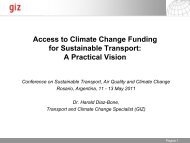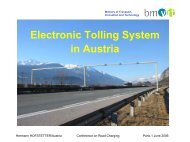CYCLE NETWORK AND ROUTE PLANNING GUIDE
CYCLE NETWORK AND ROUTE PLANNING GUIDE
CYCLE NETWORK AND ROUTE PLANNING GUIDE
You also want an ePaper? Increase the reach of your titles
YUMPU automatically turns print PDFs into web optimized ePapers that Google loves.
are accessed by car from a fastcircumferential ring road. Motor vehiclescan only travel between zones via the ringroad. Within neighbourhoods, cyclists andmotorists share the use of slow-speed (30km/h) streets. Neighbourhoods are joinedby a spine of cycle and walking paths thatprovide much shorter routes than for motortraffic. As a result, 44 percent of trips lessthan 7.5 km long are made by bicycle and23 percent by walking. Traffic crash risk ishalf that of comparable towns.Cycle path with right of way at intersection, Houten,The Netherlands. (Photo: Tim Hughes)Other examples of full segregation have notbeen so successful. Milton Keynes (UnitedKingdom) suffered from sub-standard pathdesign that has a poor safety record, andhas failed to achieve higher modal share bycycling (Franklin, 1999). Canberra’s system alsofailed to live up to the expected benefitswith only three percent of trips to workmade by bicycle. This is largely due to ahigh quality of provision for cars and a lackof directness and coherence in the cyclepath network for utility cycling. Canberra isnow retrofitting a primary cycle network tothe arterial roads.Cycle shelter near bus stop and underpass under ringroad, Houten, The Netherlands. (Photo: Tim Hughes)5.3.2 Road-based networksLand use in already-existing towns makesit impractical to develop an off-road pathnetwork, so cycle networks are basedaround the established network of (mostlyarterial) roads. There remains the issue ofwhether to provide a physically separatedpath beside the roadway.Places such as Sweden, and Copenhagenin Denmark, have made an expensivecommitment to redesigning arterial roadsto provide cycle paths on berms behindrelocated kerbs. More recently, and wherethere has not been enough funding to buildcycle paths, some European towns havetried cycle lanes as an interim measure andfound them successful.5.3.3 General considerationsMany factors influence whether roadsor paths will best suit cyclists’ needs.For example:• increased segregation from motortraffic is usually accompanied byincreased interference from pedestrians,pets, skateboarders, slower cyclists etc• one choice is not inherently safer thananother; both can be hazardous andboth require high-quality design toachieve safety — ‘the devil is in thedetail’. Paths tend to be safer betweenintersections as long as there is roomfor adequate design and minimalcrossing-driveway traffic• cycling through a junction on theroadway is generally safer than froma path. Junctions between paths andbusier roads generally require trafficcalming or signals• at junctions between paths and roads,New Zealand law requires cyclists onthe path to give way, which reducescyclist LOS• geometric design standards for roadsare often higher than for paths• it is incorrect to suggest that roads canonly satisfy commuters’ needs, or thatpaths cannot satisfy commuter cyclists’needs. Most leisure cycling takes placeon roads, and many commuters enjoywell located paths• a road is not necessarily lessexpensive to maintain but will oftenbenefit through existing pavementmanagement systems• it is usually easier and less expensiveto accommodate the needs ofcommuter cyclists on roads thanon separate paths• the freedom from traffic danger andfumes brings obvious benefits forrecreation cycling and novices(Dorrestyn, 1996a).• it is difficult to provide a coherentand direct path system that is asconvenient for commuters as thearterial road network• where origins and destinations areon the same side of an arterial road,a two-way cycle path means cyclistsdon’t have to cross the road twice to getthere. However, such two-way paths aregenerally not recommended.5.3.4 Relative advantagesSubject to appropriate design standardsbeing achieved, roads generally have thefollowing advantages over paths.They are:• direct• coherent• convenient• efficient• available everywhereand also:• have established intersection controls• serve well the needs of experiencedcyclists• have high levels of surveillance andtherefore personal security.Between intersections, isolated pathsgenerally have the following advantagesover roads. They have:• no motor traffic• slower speeds• low stress• an attractive environmentand also:• provide extra links that advantageall cyclists• serve well the needs ofnovice/child cyclists.Depending on the circumstances anddesign detail, there is usually no clearadvantage between roads and paths inrelation to:• safety• conflict with other users• expense• maintenance.31


